Far East Trade Routes
For thousands of years trade routes existed between the Middle East and Asia. Long before Marco Polo made his historic journey to China, Arab and Chinese traders moved thousands of tons of goods each year from the Far East to the Middle East and on into Europe. This trade expanded when the civilizations of Europe had money to spend, and contracted when the civilizations of Europe no longer had extra money for eastern luxuries.
So it is no surprise to discover that during the height of the Egyptian, Greek and Roman empires, Arab trade to these kingdoms was in full swing. It grew during the Byzantine Empire and even continued during the Middle Ages, for during this period, the Arab world was at its zenith and far in advance of Europe. Later when Portugal and Spain expanded their empires, Arab traders continued to trade, as these countries were now flush with gold and silver from the new world, and their desire for Asian goods far outstripped what their own fleets could provide them. So whether they sold to Europe or their own civilizations, the Arabs of the Middle East were the masters of trade from Asia right up until the time when Europe developed a world class merchant navy.
Against this background, comes the amazing fact that for over four hundred years the Nabataeans managed to monopolize much of the trade between Rome and the Far East. Not only did they monopolize the trade, they also managed, as their predecessors did, to keep the sources of their goods secret. By doing this they were the sole suppliers of many of the goods that the Romans, flush with the riches of conquest, desired.
Getting control of the incense and spice trade required a great deal of skill. For centuries, the Nabataeans had been building secret water collecting systems in the desert. These originally began as a source of protection. When challenged, the Nabataeans simply retreated into the desert. After time, however, the Nabataean settlements in the various parts of the Middle East grew more connected, and these water collection systems became the backbone of the Nabataean trade routes. This enabled them to move goods across the desert without relying on the traditional water wells as these wells were controlled by and fought over by the Bedouin tribes in the desert.
In time, the Nabataeans grew wealthy and powerful. They trained their men in military skills, and began dealing with the thieves and robbers that preyed on their trade. Also, using their small merchant ships, they pirated, pillaged, and eventually dominated the trade on the high seas, even defeating the Egyptian navy, until they totally controlled the seagoing trade between the nations of the Far East and the civilizations of Europe.
Once they gained a monopoly of much of the eastern trade, the Nabataeans began to gently squeeze the Romans for higher and higher prices. The Romans, now used to eastern luxuries, paid up. As the price rose, the Romans became worried. Their whole kingdom was dependent on the Nabataeans for the supply of incense. Incense was a necessity as it was burned in the thousands upon thousands of temples that the Romans used to worship their pantheon of gods.
Ancient manuscripts, however, make it plain that the Nabataeans were involved in far more than only transporting incense. Egypt also desired goods. Tin was imported into Egypt from Asia and/or Europe. Lapis Lazuli from Afghanistan was also imported, as was the natural volcanic glass, obsidian, from Abyssinian origin. Some items such as rare plants were imported from Africa and the Far East, which were used to manufacture the widely acclaimed Egyptian medicine.
Over the centuries, the Greeks also bought many items from the Arab traders. Greek perfumes and cosmetics have long since evaporated or turned to dust, leaving behind only written references to their importance and the containers that once held them. From Homer’s day forward, precious oils, perfumes, cosmetic powders, eye shadows, skin glosses and paints, beauty unguents, and even hair dyes seem to have been in near universal use among the Greeks. Cosmetic unguents from the east were imported into Greece in containers carved from the Red Sea Tridacna shell.
The Romans, like the civilizations before them, were also reliant on the Arab traders for many of their goods. Arab ships regularly left Red Sea ports such as Berenike in Egypt and Aila in Nabataea, bound for Indian cities. They sailed with cargoes of gold, henna, storax, frankincense, asbestos, cloth, silk gauze, silk damask, glass, and silver. Nabataean sailors never revealed the sources of their goods, and the secret of monsoon winds was closely held by their navigators. Their ships returned with cargoes of aromatic resins and spices, elephant ivory, tortoise and pearl-oyster shells, and raw silk.
Years later, in the 13th, 14th and 15th centuries, Mamluke merchants in Egypt landed Chinese and Iranian ceramics in medieval Quseir on the Red Sea. Then the Turks began sailing the western Indian Ocean in the 16th century, and at Jeddah, luxury goods from the East were traded for silver from Spain’s American colonies that had passed into the hands of Ottoman merchants. As you can see, for centuries Middle Eastern merchants controlled much of the trade between the East and the West, right up until the discovery of the Americas in 1492.
Trade on the Red Sea
Along with trade from the Far East, there was a certain amount of trade taking place in the Red Sea itself. Yemen produced frankincense and coffee. They traded these goods for necessities and also for luxuries like Chinese porcelain, fabrics and spices brought by Arab, Indian and Chinese ships to their ports.
The Jewish communities in Sana’a, the capital city of Yemen, made a date-based liquor that they sold abroad. Ports along the desert, like that of Jeddah, imported wheat, iron, oil, lentils, and beans.
The Incense Trade
For thousands of years, incense has been burned in the Middle East. Over time, it made its way to the Egyptian, Greek, and Roman temples of Europe where it became part of pagan worship ceremonies. As southern and western Europe was literally dotted with temples dedicated to pantheons of gods, tons of incense were required to keep temple worship going. Consequently, incense was in great demand and a smart merchant with a supply of incense could make a fortune for himself.
No one knows when incense first became popular in Europe’s temples, but it was possibly during Alexander the Great’s conquest of the Middle East and Persia. As the Greek Empire was breaking into smaller pieces, the Nabataean Kingdom was rising to prominence, and stepping into the power vacuum left by Alexander and his feuding generals. As the Roman Empire followed on the heels of the Greeks, Nabataean economic power surged. Suddenly their trade in rare and exotic spices, incenses, and goods from the Far East came into high demand.
Incense was not only burned before altars, it was also used as a deodorant. Even today in some parts of the Middle East, incense is still used as a deodorant. When men or women congregate for an occasion, incense is often placed in a mabkharah, or handheld charcoal brazier. Each man then opens his jacket and censes his shirt and underarms, then his face and his headscarf. The mabkharah is always passed counter-clockwise and each man wafts smoke onto himself while saying a blessing.
Incense was also used for embalming. Embalming is believed to have originated among the Egyptians before 4000 BC, and was used by them for more than 30 centuries. Historic evidence demonstrates that embalming is religious in origin, conceived as a means of preparing the dead for the life after death. From the Egyptians, the practice of embalming spread to other ancient peoples, including the Assyrians, Jews, Persians, and Scythians.
Ancient embalming methods consisted of removing the brains and viscera, and filling the bodily cavities with a mixture of incense, balsamic herbs, and other substances. The Egyptians then immersed the body in carbonate of soda, injected the arteries and veins with balsams, filled the cavities of the torso with bituminous and aromatic substances combined with salt, and finally winding cloths saturated with similar materials around the body. The Assyrians used honey in embalming, the Persians used wax, and the Jews used spices and aloes. Alexander the Great was embalmed with honey and wax. The Egyptians were particularly adept at embalming. For example, the soles of the feet of mummies, when unwrapped after as much as 3,000 years, are often still soft and elastic. Historians estimate that by AD 700, when the practice of embalming had died out, the Egyptians had embalmed over 730 million bodies. Although many were destroyed or disintegrated by the tropical heat of northern Africa, a large number of mummies were preserved. Archaeologists estimate that several million are still laying in undiscovered tombs and burial places.
In the Roman Empire, the bodies of state officials were often cremated. During the cremation process, vast quantities of incense were burned to mask the odor of burning flesh. This practice also put great demands upon the available supply of incense.
So, incense was in demand. Whether it was to be used for offering to the gods, deodorant, or embalming, it was highly desired and often very expensive. There were various kinds of incense, each one unique in its own way. Below we will look at four of these: frankincense, aloes, myrrh, and ‘ud.
Frankincense
Frankincense was obtained from several types of oriental evergreen trees or shrubs. These trees were native to Oman, Yemen, and Somaliland.
A cut was made in the bark of these trees, and the gum resin was collected. This resin was then dried and broken up into spoon sized pieces. The odor in the gum was produced by volatile oils that diffuse a strong fragrance when burned. The hardened, semi-transparent yellowish material is still used widely as ceremonial incense today. In Medieval Europe frankincense oil was thought of as a drug, and used to cleanse wounds. A refinement of frankincense was made into a gummy substance that was used to dress wounds.
Myrrh
From ancient times, the aromatic gum resin, myrrh, was extracted from a tree in Africa and Arabia, much the same way that frankincense was extracted. Then a mixture of resin, gum, and the essential oil myrrhol, was mixed to produce what was commonly known as myrrh. It had a bitter, pungent taste, and ranged in color from yellowish brown to reddish brown. It was highly valued in ancient times as an ingredient of perfume and incense, and was also used as an ointment. A similar product, known as Balm of Gilead or Mecca Myrrh, was obtained from a specific type of myrrh tree.
Myrrh is mentioned in the Bible (Psalm 45:8; Song of Solomon 4:14) and is believed to have been a mixture of myrrh and the oleoresin labdanum. One of the three gifts the Magi brought to Jesus Christ (Matthew 2:11) was myrrh. Myrrh gum resin was also used as a stimulant tonic and is even used today as an antiseptic in mouthwashes as well as to treat sore gums and teeth.
The Greek physician Hippocrates prescribed myrrh for sores and the Romans used it to treat worm infestation, coughs, and certain infections. Up to 3000 tons of frankincense and myrrh were transported each year during the height of Nabataean trade.
Aloes
The drug, bitter aloes, is obtained from the sap of the Aloe tree or shrub. There are more than 150 known species, most native to South Africa. Several species grow in Yemen and Oman, and these are thought to be the source of ancient aloes, which are often mentioned in the Bible. The bush has sword-shaped leaves which are tough, fleshy and often waxy and toothed. Today several species of aloes are commercially important as the source of the bitter-tasting aloes used in medicine.
Aloes are mentioned in several places in the Bible, and as far back as the 10th century B.C. when King Solomon began trade with the south Arabian Sabaean kingdom. Not all scholars agree but some believe that the aloes mentioned in the Bible are really ‘ud, one of the lesser known incenses.
‘ud (Pronounced ‘ood, possibly the root of our word “wood.”)
‘Ud is an aromatic resin deposit found in certain species of Aquilaria trees. These trees are found only in the jungle of the Far East, such as Borneo, Vietnam and Cambodia. ‘Ud resin is produced by the tree as an immune response to a fungus that invades the tree, and over many years, spreads through it.
For thousands of years ‘ud has made its way from the jungles of the east to the deserts of Arabia and beyond. When the fungus takes over much of the tree, it can then be harvested. Often the tree simply has patches of dark fungus, which are called gaharu by the jungle tribes. It smells like cedar and sandalwood with subtle notes of roses and balsam.
Once ‘ud reaches the markets of the Middle East it is sold as incense. Today the price can vary from $5 a gram to as high as $20 a gram. Oil can also be extracted from ‘ud that retails for at least $25 per gram and sometimes higher, depending on its quality.
In the Middle East today, ‘ud is sometimes added to tobacco and smoked in a water pipe. ‘Ud is also burned in the Great Mosque in Saudi Arabia, and pilgrims to Mecca often take packages of ‘ud home with them as souvenirs.
‘Ud is usually considered a man’s scent, but women sometimes use it at special get-togethers like weddings or the birth of a child. They pass around a smoldering incense burner so the guests can perfume themselves with ‘ud incense. If you walk past a woman on the street and you smell ‘ud you know that she is from a good family. It is a sign of wealth, good breeding, refinement, and status.
The historians of China, Friedrich Hirth and W.W. Rockhill, claim that the aloe mentioned in the Bible really was ‘ud and that as far back as 10th century BC it was traded with the Middle East. Since large volume trade was unknown at this early stage, the price of ‘ud must have been astronomical. It wasn’t until the coming of Nabataean, and the later Arab traders that larger volumes of ‘ud reached the markets of Alexandria and Rome.
Today there are shops in the Middle East that specialize in selling ‘ud. One dealer has a chain of 22 shops throughout the Middle East that sell ‘ud oils called Dahnal Oudh al-Moattaq. The price is around $900 for a 30 gram bottle.
The Spice Trade
No one knows when Arab traders first arrived in China, or when Chinese traders first traveled directly to Arabia. There are several events in history that indicate this trade was established either during the time of the Nabataeans or much earlier when Chinese and Arab traders met in Palk Bay on the northern tip of Ceylon.
It is known, however, that by 300 AD, Arab and Persian traders had established settlements on the outskirts of Canton, China. I would assume that Arabs and Persians would only establish colonies after many years of trading. One would not move women and children off to China without having first established firm relations and without a long history of stable trade. If this is true, then it clearly points to active direct trade with China taking place during the Nabataean era.
It is also interesting to note that an early Chinese traveler named Fa-Hien noted the riches of the Arab traders who dealt in ‘ud. These Arab merchants had set up their base in Ceylon (Sri Lanka) where they lived very comfortably.
The Greek geographer, Cosmas Indicopleustes, writing much later in the 6th century AD, mentions the China-Ceylon-Middle East trade routes, which he noted included large shipments of ‘ud. Several centuries later, Zayd ibn Hassan of Siraf, Iran, records in his book Silsilat al-Tawarkh (Chain of Chronicles) the experiences of two ninth-century AD traders, one Ibn Wahab of Basra and the other named Suleiman. Although they traveled at slightly different times, both reported that the price and availability of ‘ud in both Basra and Baghdad was much affected by frequent shipwrecks and pirate attacks on trading ships. A round trip took two years, as ships had to wait for the right winds so they could sail, plus they had to deal with the customs, formalities and complexities of doing business in China.
Did the Nabataeans reach China? One telling event is that in the Silk City of Tseng, in China, there is mention of Rekem in ancient records. As I mentioned earlier, Rekem was the name the Nabataeans gave to their capital city. It was only when the Romans annexed the Nabataean kingdom that they began calling the city by the Latin name: Petra. This indicates that the Nabataeans were in contact with the Chinese well before 106 AD, and most likely a century before the birth of Christ.
The Chinese were active in marine trade at various times in their history. During the Han Dynasty (206 BC - 220 AD), imperial Chinese perfume blenders used ‘ud along with cloves, musk, costus-root oil, and camphor to make Chinese perfume. Since ‘ud originated in the jungles of Borneo, the Chinese must have been active in trade with these islands.
It is also interesting to note the linguistic tie between China and India. Both the Chinese and Indian words for ‘ud means “the incense that sinks in water.” This is because a ‘water test’ is used to determine the quality of the incense. High quality incense is heavy and sinks; low quality floats.
Spices From very early times, great value was put on spices. This is best reflected by the lucrative trade in cinnamon, cassia (senna), and black pepper that began before 1000 BC in the Middle East.
For many centuries coastal trade with India was based from Arab ports along the coasts of Oman and Bahrain. From these ports, spices were gathered in the famed city of Ubar. Arab merchants controlled the overland trade routes from Ubar to Egypt and Syria. With the arrival of the Nabataeans, sea routes from Egypt were established and much of this trade moved to southern Arabian ports and the port of Aila (present day Aqaba).
From Aila, goods were carried overland to Alexandria, in Egypt, which soon became a commercial center. From the 13th to the 15th century, Venice monopolized the spice trade with the Middle East. Venice demanded such exorbitant prices, however, that Portugal and Spain looked eastward for routes to the Spice Islands around the Cape of Good Hope, and then, with the voyages of Christopher Columbus, searched westward. Although many of the early explorers set out to find gold, these expeditions gained much of their financial backing from trade in spices.
One of the greatest sources of information on shipping from India to Roman comes to us in the form of a book, known as The Periplus of the Erythraean Sea. This book lists the ports of call and the goods that were traded in each port, found along the Red Sea, the east coast of Africa, the south Arabian coast, and the western ports of India. The Periplus mentions that the king in Petra was Malichus, and thus the book can be dated to around 40 - 70 AD. Along with this, from ancient cook books, such as the Marcus Gavius Apicius: De Re Coquinaria, it is possible to discover what some of the more popular Roman cooking spices were, and how they were used. In the paragraphs below, I examine some of the cargoes that the spice ships and caravans carried from the Far East.
Indian Pepper
Pepper is the world’s most important spice today. It is prepared from peppercorn, the fruit of the pepper plant. This plant is a climbing vine native to India and widely cultivated in the hot, moist areas of tropical Asia. The vine has long, slender spikes of minute flowers and small hard fruits.
Peppercorns are harvested when they are green and immature and then allowed to dry yield black pepper. To produce white pepper, ripe peppercorns, which are red, are soaked in water and their outer covering is rubbed off.
Pepper is one of the oldest known spices and has been in use for at least 3000 years. During Roman times, pepper was only available to the upper class, which valued peppercorns almost as much as gold. When the Goths overran Rome in 410 AD, their leader, Alaric the Visigoth, demanded an initial tribute of 3000 pounds of peppercorns plus annual tributes of 300 pounds, along with gold, jewels, and silk, in order to spare their lives.
Today pepper is so common that most people fail to consider it as an exotic spice. However, thanks to the diligent work of Arab merchants over the centuries, Europeans developed a taste for this spice.
Vanilla
Vanilla is produced from a climbing orchid of the family Orchidaceae. Native to tropical America and East Asia, the flowers are thick, fleshy, and fragrant but dull in color. The fruit occurs as fleshy pods, about 15 to 23 cm (6 to 9 in) long, from which commercial vanilla is extracted. Today vanilla is commercially grown in Madagascar and Tahiti. While we do not know where the Nabataeans obtained their vanilla, we do know that the spice trade included vanilla for the kitchens of Roman Europe.
Cinnamon
Cinnamon is the common name for several related trees of the laurel family, and for a spice made from the dried bark of the trees. The best-known species were native to Sri Lanka, but today it is cultivated in many other tropical countries in south-eastern Asia and elsewhere. However, the cinnamon that is grown in Sri Lanka is still superior in taste.
The cinnamon tree, which usually grows up to 12 m (40 ft) tall, is pruned so that it grows four to five stems. When the bark begins to turn brown, the stems, which may be about 2.5 meters (8 ft) tall and 5 centimeters (2 in) in diameter at the base, are harvested and new ones are trained to grow in their place. After the stems have been stripped of leaves and twigs, the inner and outer bark is removed. As the bark dries, it forms rolls known as quills. The smaller quills are then inserted into the larger. When fully dry, these are tied in bundles for shipment.
Cinnamon is yellowish-brown and has a distinctive fragrant aroma and a sweetish, pungent taste. It has been used since early times as a spice in many culinary preparations, as well as in some medicines. The aromatic qualities of cinnamon result from a volatile oil, oil of cinnamon, which may be extracted from the bark by distillation. The oil varies in color from yellow to cherry red. The yellow oil is used in scenting soap and flavoring sweets.
Arab and Nabataean traders were key players in importing cinnamon from the east to the Middle East and Europe.
Liquid Storax
This is an aromatic gum obtained by making incisions in the trunk of the storax tree (Styrax offinale), a small deciduous tree with drooping clusters of 3-6 white flowers.
Storax is native to tropical, subtropical, and warm temperate regions throughout the world and is cultivated for ornamental effect. The white flowers, arranged in drooping groups, have a five-toothed outer floral envelope, a tubular five-toothed set of petals, ten stamens, and a solitary pistil. The several-seeded fruit splits to release the seeds. The storax tree yields a gum of the same name, which is collected from cuts made in the bark.
The hardiest species of the genus Styrax, the snowbell tree, is a deciduous shrub or small tree, 9 m (30 ft) tall, native to Japan and China, and often grown as an ornamental. A species native to Borneo, Java, and the Malay Peninsula yields the important resin called benzoin, also known as gum Benjamin, which is an important component of friar’s balsam.
Gum Arabic
Gum Arabic is a resin, which seeps from the branches of several species of the Acacia tree. This small tree or shrub is native to dry areas in Africa, from Senegal to Nigeria. The gum forms a clear, thick solution in water. When ethyl alcohol is added to a solution of Gum Arabic and water, which has been slightly acidified with hydrochloric acid, arabin is produced. This gum is harvested during the dry season, and is used as an adhesive, in ink, and as well in the manufacture of candy. Arabs use this gum today to produce a number of different kinds of sweets and deserts.
Cloves
Cloves are produced from an evergreen tree (Syzygium aromaticum) that grows as high as 12 meters (40 feet.) It is native to the Moluccas area in eastern Indonesia but today it is cultivated elsewhere. The leaves of the clove tree are lance-shaped and the flowers are yellow with clusters of four petals. The trees produce a great profusion of flowers.
The leaves, flowers, and bark of the clove tree are all aromatic. The ripe fruit resembles an olive in shape but is smaller. It is dark red and is sometimes sold in a dried state, known as ‘mother clove.’ In this form it has an aroma and flavor similar to those of cloves but much weaker.
The spice that most of us know as cloves is made from the flowers. The flower buds are gathered and dried by exposure to the smoke of a wood fire as well as in the rays of the sun.
Cloves are used extensively as a condiment and flavoring in many types of cooking. Oil is obtained from cloves by repeated distilling. In dentistry, this oil is used as an anesthetic and sometimes as an antiseptic. It is also used in perfumes and soaps.
Cloves were highly prized in ancient times, and must have been a welcome cargo aboard any Nabataean trading boat.
Musk
Musk is produced from the abdominal gland on the male musk deer, found in high Asian mountains. The long-lasting odor of musk has made it an important ingredient in perfumes throughout history. Musk also delays evaporation of more volatile scents in a perfume, and is used as a fixative in blends where other scents are dominant. In Asia, it is sought as an aphrodisiac, and it is believed to be medically beneficial as a stimulant. Fresh musk is very thick and sticky but dries to a grainy powder, a tincture of which is used in perfumes. The basic oil, that is the source of the odor, has been identified and called muskone. There are records of musk being used in perfume as early as 200 BC.
Ginger
Ginger is found throughout the tropics, mostly in Far Eastern countries. It has unique complicated flowers with a fertile stamen and a prominent lip. Most of us associate ginger with the knobby fat roots that are sold in supermarkets today. However, from the ginger plant we get not only the root spice, but also East Indian arrowroot, turmeric, and prized flowers. Ginger as a spice was well known to the Romans, but after the fall of Rome, much of the trade with the east was lost, and it was only after Marco Polo’s trip that ginger once again found its ways into the kitchens of Europe.
Nutmeg
Nutmeg is an evergreen tree that is native to the Moluccas area of east Indonesia. Today it is widely cultivated in southern Asia, the West Indies, and Brazil for its fruits, which yield two spices, and for its timber. The fruit is fleshy and yellow having a diameter of about 5 centimeters (2 inches), popularly called the nutmeg apple, which splits into two halves, thereby revealing the seed surrounded by an outer coating resembling a fleshy, reddish net. This seed is dried to form the spice popularly known as nutmeg. The fleshy reddish coat around the seed is peeled off and dried to form the spice known as mace. Nutmeg trees grow to a height of about 15 meters (50 feet).
Other Trade Items
Along with incense and spices, the Nabataeans were also merchants of many other items, including various rocks, gems, glass, and metals. Using their fleets of merchant ships and camel caravans, they transported these items to the markets of Greece, Egypt, and Rome. Below I have listed some of the things they transported.
Obsidian
Obsidian is a black volcanic glass that yields sharp blades. Obsidian is produced when molten igneous rock (magma) pushes its way up to the earth’s surface. If the lava cools rapidly, it does not have time to crystallize and obsidian forms. Obsidian is usually black, but may also be red or brown. Because it is easy to shape by flaking, it was prized since early times by peoples who used it to make weapons and tools.
All of the early civilizations of Asia Minor, North Africa, and Europe relied on the Arabian Peninsula for their supplies of obsidian. Tools from Arabian obsidian have been found in Egyptian pre-dynastic archeological sites demonstrating that this trade was in place many centuries before the Nabataeans came onto the scene. During the height of Nabataean trade, obsidian continued to be listed as a frequent cargo on boats arriving from Asia.
Turquoise
Turquoise is an opaque, cryptocrystalline mineral, composed chiefly of hydrated aluminum phosphate that is prized throughout the world as a gemstone.
The color ranges from blue and bright blue-green to greenish-grey, according to the various amounts of copper usually present. It occurs mostly in seams of igneous rocks, as incrustations on the surface of various slates, or as nodules in red sandstone. The sky-blue variety of turquoise, commonly referred to as robin’s egg, is the form most desired for jewelry.
The principal deposits of blue turquoise are located in Iran and the Sinai Peninsula. The mineral has been valued for its ornamental properties since ancient times and has been found in neckwear and bracelets recovered from old Egyptian tombs. Ancient boats have been recovered from the Red Sea carrying turquoise in their cargoes.
Lapis Lazuli
This deep blue rock has also been used since ancient times for ornamental purposes. It consists essentially of the blue mineral lazurite and contains small amounts of calcite, pyroxene, and other silicates. Small particles of pyrite give the appearance of gold specks and are usually disseminated through the blue rock.
The best-quality lapis lazuli, which contains less calcite and pyrite, comes from Afghanistan, where the mines have been worked for many thousands of years. Lapis lazuli has been used for more than 6,000 years. The death mask of the young pharaoh Tutankhamen was inlaid with stone mined in Afghanistan. It was also used for mosaics and other inlaid work, carved ornaments, vases, and jewelry, especially beads. As a gem, it was usually cut to be smooth and rounded and could be used to make cameos. Lapis lazuli was also ground and used as blue pigment (ultramarine) until the early 19th century, when artificial ultramarine was developed.
This stone is very popular in the Middle East today and is sometimes used in the manufacture of Muslim prayer beads.
Copper
Since early times, copper has been an important element. As it is easily refined and worked, copper was in demand for the manufacture of military equipment, pots, and even as a writing material.
The presence of copper in Palestine is mentioned in the Bible, and archaeologists have identified remnants of ancient smelting operations at Timna’. This town was located on the western side of Wadi Arabah. As you will notice on a map, Wadi Arabah runs down the west side of the mountains of Petra. The ancient mines, called Mikhrot Shelomo ha-Melekh (“King Solomon’s Mines”), are at the top of a mesa, about 300 meters (1,000 feet) long and more than 130 meters (425 feet) wide at its widest point. The mesa’s north wall contains scenic columnar rock formations that show traces of copper to this day.
Today there are modern mines east of this site. Because of the extreme heat, especially in the summer months, the mineworkers commute to the works from Elat, 25 kilometers (15.5 miles) south.
As the need for copper grew, this metal became a source of foreign trade, and one that the Nabataeans did not fail to participate in.
Wadi Arabah is liberally dotted with ancient copper slagheaps denoting extensive mining and working of metal, long before the appearance of the Nabataeans. The Khirbet Nahas site, which in Arabic, means ‘Copper Ruin,’ was a great mining and smelting complex and located near the Nabataean center of Selah.
Bronze
Bronze is made when arsenic and/or tin is present with copper. Bronze is both stronger and more durable than copper, and so it was in greater demand. Arsenic content varied from 1 to 7 percent, with up to 3 percent tin in early bronze making. Arsenic-free copper alloys with higher tin content (in other words, true bronze) seem to have appeared between 3000 and 2500 BC, beginning in the Tigris-Euphrates delta. The discovery of the value of tin may have occurred through the use of stannite, a mixed sulfide of copper, iron, and tin, although this mineral is not as widely available as cassiterite, in which the main metal is tin. This eventually must have been the main source of the metal.
While there may have been some independent development of bronze in varying localities, it is most likely that the bronze culture spread through trade and the migration of peoples from the Middle East to Egypt, Europe, and possibly China. In many civilizations the production of copper, arsenical copper, and tin-bronze continued together for some time. The eventual disappearance of copper-arsenic alloys is difficult to explain. Production may have been based on minerals that were not widely available and became scarce, but the relative scarcity of tin minerals did not prevent a substantial trade in that metal over considerable distances. It may be that tin bronzes were eventually preferred owing to the chance of contracting arsenic poisoning from fumes produced by the oxidation of arsenic-containing minerals. However, in the end, the use of iron replaced Bronze, as iron was in much greater supply.
As the weathered copper ores in given localities were worked out, the harder sulfide ores beneath were mined and smelted. The minerals involved, such as chalcopyrite, a copper-iron sulfide, needed an oxidizing roast to remove sulfur as sulfur dioxide and yield copper oxide. This not only required greater metallurgical skill but also oxidized iron content. Improved smelting furnaces led to higher iron contents in the bronze.
As I mentioned earlier, copper and bronze formed an integral part of all early trade. As copper and ultimately bronze were mined and worked in the Middle East, products made of these metals were exported to other locations.
Tin
Tin was important in the production of bronze. Tin was also used as a soft metal. Since early times there are records of tin being imported into Egypt from Asia. So it comes as no surprise that the Nabataeans also included tin in their items of trade.
Iron
Iron technology was derived from the art of refining and working copper and bronze. The main requirement for working iron was a furnace capable of maintaining a high temperature by means of a good draft of air. The furnace had to be tall enough to allow the iron to drop from the smelting zone and form a lump usually called a bloom.
After aluminum, iron is the most abundant metal on earth, constituting about 5 percent of the earth’s crust. Copper was always in short supply, as it makes up only 0.01 percent of the earth’s crust, but iron ore suitable for simple smelting was widely distributed in the form of surface deposits that could be scraped up without elaborate mining procedures.
During the Bronze Age, there were limitations on the materials that could be produced, and there was a dearth of copper and bronze ore. Once man learned how to work iron, new tools and implements became possible, and their numbers could increase until even the poorer classes had access to metal tools and weapons. The iron of antiquity was wrought iron, a malleable and weldable material whose toughness was enhanced by forging. The brittle cast iron that is so common today was unknown to the ancients, and it would have been of no value for their edged tools and implements. The earliest history of smelted iron is obscure, with the first scanty evidence of man-made iron dating from about 2500 BC in the Middle East. A thousand years later the Hittites abandoned the use of copper and bronze as their main metal and began to use iron.
All during the Egyptian, Greek, and Roman empires, iron was a valued commodity. Although it was present in many places, iron mines were considered strategically important. So it is interesting to notice that the iron and copper mines in Wadi Arabah, were the only iron and copper mines in Canaan. Consequently, Wadi Arabah was frequently fought over in Biblical times by the kings of Judah and Edom.
As the Nabataeans arrived in Wadi Arabah, they took over the iron mining business, often acting as agents in the production and trade of iron. So it was that objects made of iron were an integral part of any Nabataean caravan.
Arsenic
Arsenic has been known since ancient times. It is a pure element that can be easily prepared by heating a common ore called arsenopyrite. Occasionally the pure element is found in nature but arsenic usually occurs in the ores of many of the heavy metals. When these ores are roasted, the arsenic can be collected from dust in the flues as a by-product. Over time, arsenic was used in large quantities in the manufacture of glass to eliminate the green color caused by impurities in the iron compounds. A typical charge in a glass furnace contains 0.5 per cent of arsenic trioxide. Also, occasionally, arsenic was added to lead to harden it. Arsenic was such a useful industrial compound, that it was natural that it became one of the materials that the Nabataeans carried on their boats. Trade in arsenic continued for several centuries, with arsenic being listed as a cargo item on Arab boats until the Middle Ages. Arsenic however, was more than just an industrial product. Until the introduction of penicillin in the 1940s, arsenic was of great importance in the treatment of syphilis. Along with this, arsenic was also considered a poison of choice as doses larger than 65 milligrams (1 grain) are lethal, but, poisoning can also arise from repeated small doses, as, for example, inhalation of arsenical gases or dust.
Glass
Glass is made by heating a mixture of materials such as sand, soda, and limestone to a temperature of about 1,300 degrees Celsius (2,400 degrees Fahrenheit). Early attempts at glass-making used wood fires, but wood produces temperatures slightly lower than what is required for good glass-making.
Glass was used as early as 3000 BC in Egypt as a decorative colored glaze on stone or pottery beads. The art of making glass was perfected about 1500 BC in Egypt and the Near East and many small ornaments and objects were made. Glassblowing, however, was probably discovered about 50 BC in Phoenicia. This greatly extended the types of objects that could be made of glass. It also made objects easier to fabricate and more transparent.
Glass containers such as bottles and jars were made by blowing hot glass into a mold. Certain glass objects such as plates, tumblers, and vases were made by pressing hot glass in a mold.
The art of glassblowing spread rapidly throughout the Roman Empire, with special centers of glassmaking being established in Phoenicia, Rome, Egypt, the Rhineland, and the Rhone Valley. As a result glassware became common and relatively inexpensive.
After the fall of the West Roman Empire near the end of the 5th century, glassmaking decreased in importance in Western Europe, as did many other technologies and arts. Artistic glass almost disappeared. In Byzantium, however, Greek and Syrian glass centers continued to prosper.
Ancient glass often was colored from various impurities: chromates produced green, copper and cobalt produced blue, and manganese produced purple. The common green of ancient bottles resulted from the addition of oxidized iron. Brown glass was made by adding a combination of iron and sulfur. Very small metal particles in glass color it deeply; for instance, the addition of gold produced ruby-colored glass. Red glass was also made by adding copper or selenium.
Hand-blown glass bottles were being made in Rome near the turn of the millennium. These bottles and the popular mosaics of the period were probably the work of glass blowers from Alexandria, Egypt, and Syria. Syrian glass workers were known to have traveled as far north as Reims, in France. A unique type of Roman glass known as millefiori (“thousand flowers”) consisted of long canes of variously colored glass that were cut into small segments and implanted into glass bowls to form a pattern. Roman cameo glass was made by applying a white overlay to blue glass and carving away part of the overlay. Glass that had been buried in the earth for a long time acquired an opalescent quality that was caused by the flaking of the surface. This appearance is considered a disease today, but in Roman bottles the rainbow like surface added to both its value and appeal.
Middle Eastern and Roman glassware were transported by Arab merchants to many parts of Africa and Asia.
Beads
For many centuries, the production and trade in beads was considered very important. For many years, however, western historians have overlooked the importance of the bead trade. A common practice in the past has been that of calling every unidentified glass bead as ‘Roman.’ This label was used even when the bead in question could not have been Roman, as for example beads that have been identified as Islamic. However, in the last few years, the study of bead production and trade has finally been accepted in academic circles. Now it is clear that long before the Romans, glass beads were made in the Middle East and Asia, and long after the Romans, beads were made in Byzantine and Coptic territories, later to become Islamic regions.
Glass, for the first millennium of its use, was mostly made into beads. Because it was a novelty, made by a secret process, and was attractive, glass was viewed as a gem or gem substitute and the many uses we have for it today were not even thought of in its early history.
Bead making spread from Mesopotamia to neighboring regions, especially the Levant (Syria, Israel, Lebanon) and by 1000 B.C. spread to parts of Europe. The beads made by these industries were all produced by the ancient method of furnace winding. This technique persisted in Europe until the last few centuries and was also common in the Middle East. Arab traders were quick to notice the bead trade, and began transporting the furnace-wound beads of Egypt and the Middle East to East Asia. But, interestingly enough, they also brought glass beads back from India to Europe.
Some of this can be seen from excavations of the Ptolemaic Egyptian Red Sea port of Berenike, where connections with South Asia have been found. The excavations produced Indian printed textiles, Indian sailcloth, Indian strings (with beads on them), and other Indian products, including teak wood, bamboo, Job’s Tears, amalaka, and black peppers and beads from Mantai in Sri Lanka and India.
India was home to several major glass bead industries whose products had been leaders in the global bead commerce since before Roman times. There were also two stone bead industries, one located in western India and the other in the south. Because the Indians used intermediaries as Nabataean merchants, they successfully hid the details of these industries from their best customer, the Romans.
India pioneered the making of hard stone beads from lapis lazuli and carnelian, and began exporting these beads centuries before the Romans. They also imported coral beads from Arabia. India also developed the darkened agate (gem onyx), etched carnelians, and other altered bead types.
The unique Indo-Pacific bead that originated in Arikamedu, India, was probably the greatest trade bead of all time. Archeologists have now worked out the details of their production.
These small Indian beads were cut from a tube of glass, and have been found in archaeological sites stretching from Ghana to China, Mali to Bali, and South Africa to South Korea. These beads were made by a unique method developed in South India several centuries B.C. The technique is still used today by Indian bead makers.
It requires a couple dozen men and women, three furnaces, two of them unique to the system, and specialized tools. Glassmakers prepare a large cake of glass and add it slowly to a unique tube-drawing furnace.
From this furnace, they produce tubes of glass about a meter in length. It takes about three hours to work 50 kilograms (about 100 pounds) into tubes. These tubes are then chopped between two blades, packed in ash, and stirred over heat for 30 minutes to round off their sharp edges. They are then strung up by women with long needles, passing them through the beads.
It is interesting to notice that this tube-drawing process is very similar in conception to the machine that Edward Danner of the Libby Glass Company patented in 1917 to draw glass tubing automatically. This process is also identical to the way that artisans in Venice processed glass tubes until the introduction of machines in the 1860s. There is no question that the Indians were doing this for two millennia or more before either Venice or Danner.
And what’s more, the Indian beads have been found in royal and noble tombs in China (particularly Annam and Guangzhou), in royal tombs in Silla and Paekche, Korea, and also in Japan.
These beads were first made in a port city on the southeast coast of India, known today as Arikamedu. In time, some of the bead makers left to expand their trade. From around the first century A.D. until around 1200 AD, Indian bead makers were living in Vietnam, Thailand, Malaysia, Indonesia, and Sri Lanka, as well as their old home in India. Production was so enormous that for 1200 years, in the relatively remote Philippines, Indian beads accounted for two-thirds of all beads of all kinds excavated at all archaeological sites.
Indo-Pacific beads also went west. Arab traders took them to trade into Africa. They are found all along Madagascar, along the east coast, and along the west coast as far as the northern Forest Zone of West Africa. It is no exaggeration to say that Indian beads were the greatest trade beads, and perhaps the greatest trade items of all time.
Silk
Most school children can tell you that silk originated in China and that Marco Polo was the first western explorer to learn of it, and bring it back to Europe.
What many people don’t know, however, is that silk was a prized cloth during Roman times. Silk is recorded as one of the many trade items that made its way via Arab traders to the Roman Empire. In fact, during the time of the Roman Empire, the civilizations of the Middle East developed new ways of weaving silk that was unknown in China. These techniques were peculiar to two Nabataean cities, and it brought them a reputation that has persisted to this day. Damascus gave its name to damask silk while our word gauze is derived from Gaza.
However, no articles of Chinese manufacture have ever been discovered in Nabataean cities. This suggests that all imports from China were perishables, such as spices, silk thread, and cloth, which could not have stood the test of time in the harsh Middle Eastern climate. However, the ancient seafaring records and cargo lists clearly tell us that silk was one of the items that the Arabs brought to the Romans.
During the Middle Ages, most trade with China was lost and it wasn’t until Marco Polo’s famous journey that silk once again became a much desired luxury in the home of wealthy Europeans.
Gold
Wherever caravans went, gold went. Gold was the universal currency that traders dealt in. Coins were minted from gold and sometimes from silver, and were in large circulation during Roman times. Large caches of Roman gold coins have been found as far away as India where they probably acted as bullion. The Nabataeans themselves minted coins, but this will be examined later in the chapter on Nabataean economics.
As trade ships and caravans carried many valuables, they had to be protected. Since the Nabataeans had started out their sailing days as pirates, they seem to have become masters of the seas and may not have had trouble with other pirates. On land however, the Nabataeans developed a series of forts and caravan stops, all along the caravan routes. At many of these spots, archeologists have discovered the remains of barracks where soldiers were stationed to protect the wealthy merchants and their priceless cargos and loads of gold and jewelry.
Plants
Rare plants were imported from Africa and the Far East, which were used to manufacture the widely acclaimed Egyptian medicines.
Greece and Hellenistic culture were overly occupied with the human form. Into this market, the Nabataeans stepped with perfumes and cosmetics from the East.
Other items that could be found among the Nabataeans cargo were costus root oil, coconuts, black-lipped pearl-oyster shells, earthenware vessels, Chinese porcelain, soccatrina, exotic animals, sugar, ivory, and coffee from Yemen.
Return Trade
The Nabataeans were skilled businessmen, and so they discovered that there were cargoes that they could carry on their return journey. Some items, such as silk, they managed to move in both directions, bringing raw silk from China to the Middle East, and then returning with the finished product, either in the form of gauze or damask silk. The Periplus Maris Erythraei also mentions many items that the cargo boats carried to the East, including coral, olive oil, grain, wine, rice, sesame oil, ghee, cane sugar, dates, clothing, tools and metal implements and even slaves.
The Bitumen Industry
Bitumen from the Dead Sea may well be among the most intriguing of the many trade items that passed through Nabataean hands. Bitumen or tar had been gathered and sold to the Egyptians for many centuries by those who lived on the shores of the Dead Sea. Over time, the Nabataeans gained a monopoly on this product and consequently they came to the attention of the military powers in Damascus.
The earliest historical mention of Dead Sea bitumen is found in Genesis 14 where the scriptures tell us of battles fought in the area of the bitumen pits.
“In the days of Amraphel king of Shinar, Arioch king of Ellasar, Chedorlamer king of Elam, and Tidal king of Goiim, these kings made war with Bera king of Sodom, Birsha king of Gomorrah, Shinab king of Admah, Shemeber king of Zeboiim and the king of Bela (that is Zoar). And all these joined forces in the valley of Siddim, that is, the Salt Sea.” Genesis 14:1
“Now the Valley of Siddim was full of Bitumen pits; and as the kings of Sodom and Gomorrah fled, some fell into them, and the rest fled to the mountains.” Genesis 14:10
The time setting for this event would have been during the life of Abraham, who is generally considered to have lived around 1750 BC. This is the first literary evidence of bitumen in this area.
The Egyptians used bitumen in the embalming process as well as for waterproofing coffins and other articles. Another common practice was to use bitumen as a cement or binding agent. In addition, this substance was employed in the manufacture of imitation gems and in the coloring and production of metals.
The Dead Sea, known in antiquity as Lacus Asphaltites (Asphalt Lake), produced the bitumen, which the local inhabitants harvested to sell to Egypt. The Dead Sea was relatively close to the Nabataean center at Selah. As Nabataean power grew, they managed to gain control of this industry.
The following comes from Strabo’s Geography Book 16. 2.42-46 (The Dead Sea) is large; in fact some state that it is one thousand stadia in circuit; however, it extends parallel to the coast to a length of slightly more than two hundred stadia, is deep to the very shore, and has water so very heavy that there is no use for divers, and any person who walks into it and proceeds no further than up to his navel is immediately raised afloat.
It is full of asphalt. The asphalt is blown to the surface at irregular intervals from the midst of the deep, and with it bubbles raise, as though the water were boiling; and the surface of the lake, being convex, presents the appearance of a hill. With the asphalt there arises too much soot which though smoky is imperceptible to the eye; and it tarnishes copper and silver and everything that glistens, even gold; and when their vessels are becoming tarnished the people who live round the lake know that the asphalt is beginning to rise; and they prepare to collect it by means of rafts made of reed.
The asphalt is a clod of earth which at first is liquefied by heat, and is blown up to the surface and spreads out; and then again by reason of the cold water, the kind of water the lake in question has, it changes to a firm, solidified substance, and therefore requires cutting and chopping; and then it floats, because of the nature of the water, owing to which, as I was saying, there is no use for divers; and no person who walks into it can immerse himself either, but is raised afloat. They reach the asphalt on rafts and chop it and carry off as much as they can.
It is reasonable that this behavior should occur in the middle of the lake, because the source of the fire and also the greater part of the asphalt is at the middle of it; but the bubbling up is irregular because the movement of the fire, like that of many other subterranean blasts, follows no order known to us. Such also, are the phenomena at Apollonia in Epirus.
Many other evidences are produced to show that the country is fiery; for near Moasada are to be seen rugged rocks that have been scorched, as also in many places, fissures and ashy soil, and drops of pitch dropping from smooth cliffs, and boiling rivers that emit foul odors to a great distance, and ruined settlements here and there; and therefore people believe the oft-repeated assertions of the local inhabitants that there were once thirteen inhabited cities in that region of which Sodom was the metropolis, but that a circuit of about sixty stadia of that city escaped unharmed; and that by reason of earthquakes and of eruptions of fire and of hot waters containing asphalt and sulfur, the lake burst its bounds and rocks were enveloped with fire; and as far as the cities, some were swallowed up and others were abandoned by such as were able to escape…The Egyptians use the asphalt for embalming the bodies of the dead.
Diodorus Siculus (c. 80-20 B.C.) wrote the following passage concerning the Nabataean bitumen (asphalt) industry on the Dead Sea in Book II.48.6-9 in his Bibliotheca Historica.
On occasion, asphalt may still be observed floating on the surface of the Dead Sea. There is also in the land of the Nabataeans …a large lake … which produces asphalt in abundance, and from it they derive not a little revenue. It has a length of about five hundred states and a width of about sixty, and its water is so ill-smelling and so very bitter that it cannot support fish or any of the other animals which commonly live in water. And although great rivers of remarkable sweetness empty into it, the lake gets the better of them by reason of its evil smell.
From its center it spouts forth once a year a great mass of asphalt, which sometimes extends for more than three plethora, and sometimes for only two; and when this occurs the barbarians who live about the lake usually call the larger flow a “bull” and to the smaller one they give the name “calf.” Since the asphalt floats on the surface of the lake, to those who view it from a distance it takes the appearance of an island.
The fact is that the emission of the asphalt is made known to the natives twenty days before it takes place; for to a distance of many stadia around the lake the odor, borne on the wind assails them, and every piece of silver and gold and brass in the locality loses its characteristic luster. But this returns again as soon as all the asphalt has been spouted forth; and the region round about, by reason of its being exposed to fire and to the evil odors, renders the bodies of the inhabitants susceptible to disease and makes the people very short-lived.”
An examination of the Nabataean bitumen industry reveals that the Nabataeans were not simply sailors and caravan masters. They were also resourceful entrepreneurs providing a necessary product to an essential Egyptian industry, that of embalming the dead. Bitumen was a valuable commodity, which the Nabataeans continuously struggled to retain and protect.
Bitumen was an important economic and political factor in the eastern Mediterranean and the Nabataeans fiercely strove to protect their monopoly. Diodorus records how, in 312 B.C., they decisively repulsed attacks launched by one of the early contenders for Alexander the Great’s empire, Antigonus One-Eyed. Antigonus attempted to seize the lucrative bitumen trade with Egypt for himself. As we mentioned earlier, this confrontation launched the Nabataeans onto the stage of recorded world history.
During the first century BC, the Nabataeans faced a new and increasing threat to their independence. In 62 BC Scaurus, a Roman officer under Pompey led an expedition against Petra. He was unsuccessful in taking the city but the Nabataeans offered him silver to withdraw. Josephus in Antiquities of the Jews, recounts the following:
Scaurus made now an expedition against Petra in Arabia, and set on fire all the places round about it, because of the great difficulty of access to it …his army was pinched by famine … (The Judean King) Antipater was sent to Aretas (King of Nabataea)] as an ambassador, by Scaurus, because he had lived with him formerly, he persuaded Aretas to give Scaurus a sum of money, to prevent the burning of his country; and undertook to be his surety for three hundred talents. So Scaurus, upon these terms ceased to make war any longer; which was done as much at Scaurus’ desire as at the desire of Aretas.
Seven years later, encouraged by Scaurus’ silver windfall, Roman commander, Gabinius invaded Nabataea and demanded and received a similar inducement to depart. Roman demands became even bolder. Marc Antony annexed the kingdom ca. 36 BC and gave the Dead Sea region with its bitumen to Cleopatra. Again, from Josephus’ Antiquities, IV:1:
Now at this time the affairs of Syria were in confusion by Cleopatra’s constant persuasions to Antony to make an attempt upon everybody’s dominions; for she persuaded him to take those dominions away from their several princes and bestow them upon her; and she had a mighty influence upon him, by reason of his being enslaved to her by his affections … She also petitioned Antony to give her Judea and Arabia; and, in order thereto desired him to take these countries away from their present governors.
After Cleopatra obtained control of the Dead Sea bitumen industry, she cleverly developed a way to maximize the income from the operation while insuring the continued flow of bitumen into her kingdom. She leased the Dead Sea bitumen industry back to Nabataean King Malichus I for 200 talents (the modern equivalent of $400,000/year) and she arranged for King Herod of Judea to collect it and pass it on to her. Thus, through this arrangement, she would receive considerable revenue without any monetary, military, or labor expenditures.
However, such a financial toll on the Nabataeans soon became unbearable. Before long, King Malichus, under pressure from his Council of Elders, began to defy the Egyptian Queen. Josephus, in his Antiquities IV: 4, records the following:
As for the King of Arabia, whose tribute Herod had undertaken to pay her, for some time indeed he paid him as much as came to two hundred talents; but he afterward became very niggardly and slow in his payments, and could hardly be brought to pay some parts of it, and was not willing to pay even them without some deductions.
Cleopatra called on Antony to launch a punitive campaign against Nabataea. This would be led by his protégé Judean King Herod. Ultimately, this turned out badly for the Queen. The Nabataeans defeated Herod in the battle of Qanawat, and shortly after, in 31 BC, Antony was defeated at Actium.
Then, Cleopatra’s heavy-handed policy toward the Nabataeans came back to haunt her. In a desperate attempt to escape to India, she had some of her ships dragged overland from the Nile to the Red Sea. As it happened, the Nabataeans caught wind of this.
No sooner were Cleopatra’s ships launched than the Nabataean navy attacked and burned them. Estimates are that Cleopatra lost sixty ships. With the Red Sea escape route cut off, Antony and Cleopatra were forced to flee to Alexandria where they committed suicide. Egypt then became a colony of Augustus’ emerging Roman Empire after Cleopatra’s death.
The bitumen industry went belly-up after the Egyptian and Romans stopped practicing mummification. Several mummies from Roman time have survived. These were Roman citizens who “went native” in Egypt. You can recognize them because on the wrappings they painted remarkably lifelike portraits of who was inside.
Christianity’s arrival killed the practice of mummification. Christianity teaches that God will give believers new bodies when they are resurrected, so there was no need to keep the old body around anymore.
However, while mummification was still practiced, hundreds of thousands of Egyptians were embalmed, all with bitumen from Nabataea.

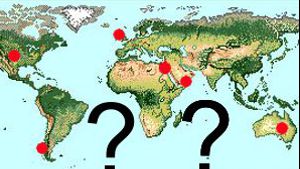
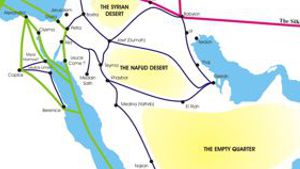
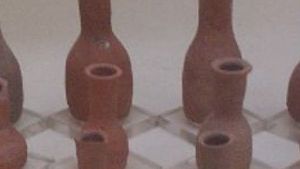
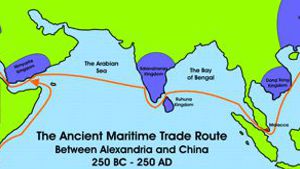
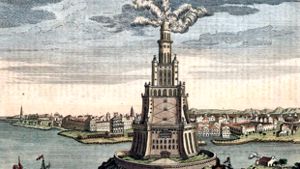







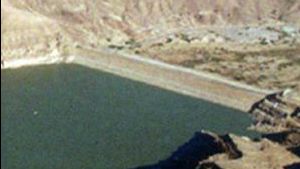
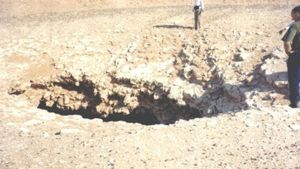

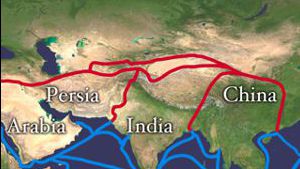
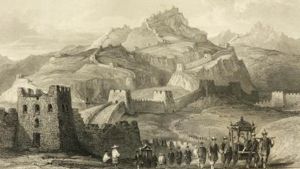

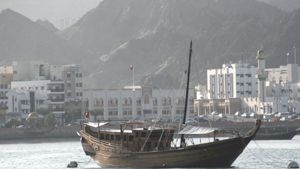

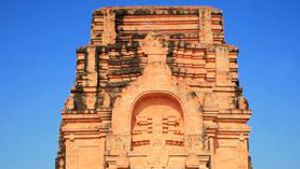

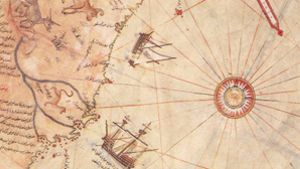
Page Discussion
Membership is required to comment. Membership is free of charge and available to everyone over the age of 16. Just click SignUp, or make a comment below. You will need a user name and a password. The system will automatically send a code to your email address. It should arrive in a few minutes. Enter the code, and you are finished.
Members who post adverts or use inappropriate language or make disrespectful comments will have their membership removed and be barred from the site. By becoming a member you agree to our Terms of Use and our Privacy, Cookies & Ad Policies. Remember that we will never, under any circumstances, sell or give your email address or private information to anyone unless required by law. Please keep your comments on topic. Thanks!